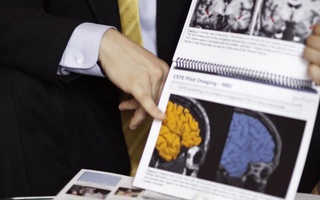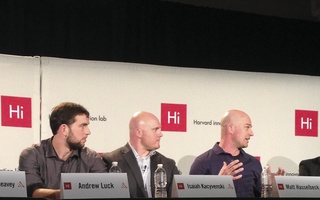Nowinski is now a prominent voice on an issue that is increasing in public awareness every day. Considered an expert in the field of concussion-related research, his work was featured on ESPN’s Outside the Lines in September 2007 and CBS’ 60 Minutes in October 2009. Sports Illustrated’s Pablo Torre ’05, a former Crimson editor, nominated him for Sportsman of the Year in 2010. Next year’s version of the popular Madden football video game will feature concussions for the first time.
“From 2006 to now the culture of the game is so much different and a lot of that can be attributed to Chris,” Kacyvenski says. “He has been the driving force—this thing could have died. It’s not like he’s got a huge head; he doesn’t care about [success]. He just wants to ensure safety, to ensure the pathway to research that’s not biased without any agendas.”
Nowinski’s work also influenced Schwarz to pursue the topic, and the journalist has since written over 200 articles on the concussions problem.
“There’s no person more singularly responsible for raising public awareness of concussions than Chris Nowinski,” Schwarz says. “I am given a lot of credit for being that person, but I wouldn’t have had anything to write about had Chris not educated me for the first year or so.”
In 2010, CSTE’s research discovered the first pathological link between head trauma and such neurological diseases as ALS.
But the tragic deaths that seem to be linked to repeated concussions have continued.
In April 2010, after Penn football captain Owen Thomas committed suicide, examination of his brain revealed that CTE had led to Thomas’ depression. Ten months later, former Chicago Bears defensive back Dave Duerson took his own life by shooting himself in the chest, leaving a note requesting his brain be given to the NFL’s Brain Bank at BU to be examined for the same type of damage found in other decreased NFL players. The brain was sent to the CSTE, where Duerson’s self-hypothesis was confirmed. He too had suffered from CTE.
To Nowinski, these sad cases show that young athletes still need to be educated about the dangers associated with head trauma.
“We want to provide people with information and inspiration to play sports more safely,” he says. “[Our presentations] revolve around stories of mistakes that we’ve made, showing the brains of athletes who have taken their own lives, and helping people understand that they have a moral obligation to protect kids because kids aren’t old enough to accept the risks that we expose them to.”
Presently, more than 300 athletes, including 100 current and former NFL players, are on the CSTE’s brain donation registry, with 65 cases currently being studied.
“Chris has been very instrumental in bringing awareness to the potentially serious ramifications of concussions in sports,” NFL spokesperson Greg Aiello wrote in an email. “He has been a leader on this issue, and we have worked with him and supported his Boston University research group. Chris is a great example of someone making a positive difference for millions of young athletes and their parents.”
Knowledge about brain injury is starting to spread to other sports as well. On May 13, 2011, after suffering a concussion that caused him to miss half this season, New York Rangers left wing Derek Boogaard was found dead in his apartment at the age of 28. Boogaard’s family agreed to have his brain donated to the CSTE at BU, where it is presently being examined for CTE. The CSTE had previously found the disease in the brain of former Chicago Blackhawks enforcer Bob Probert, who died in July 2010.
Because of those types of cases, Nowinski’s long-term goal is to develop a diagnostic test for CTE while players are still living, and then to find a cure and treatment.
Kacyvenski has faith that his friend can accomplish this and much more.
“Chris has a brilliant mind,” he says. “He’s unbelievably intellectual, able to command a room and able to say what he has to say in a manner that’s pleasing to all sides. He believes that he can change the world. There weren’t many people who saw his vision, or a huge amount of people that understood. But he stayed on it, and it’s impressive to see him every step of the way. Moral of the story about Chris Nowinski: don’t bet against him, ever.”
Read more in Sports
TEAM OF THE YEAR RUNNER-UP: Crimson Dominates Nation’s BestRecommended Articles
-
Ivy League Leads Trend in Concussion PreventionThe winds of change howling through the world of sports safety have become impossible to ignore. Traditional football has nearly been toppled by the gusts, and the winds’ next victim, hockey, lies just around the corner. Adding to the drafts is none other than our little Ivy League. The breezes began back in 2009, when the NFL was called out by Congress for not adequately protecting its players from the dangers of concussions and other head injuries.
-
Who You Should Root for in the NFL PlayoffsHome team knocked out of the playoffs? Still reeling from Fitzpatrick’s fourth place AFC East finish? The Back Page has ...
-
 Concussed: Down and Out
Concussed: Down and Out -
Panelists Discuss Head Trauma ResearchThree panelists described current medical research and long-term goals to reform care and policy on athletic head trauma and concussions during a biannual symposium of the Harvard Society for Mind, Brain, and Behavior in Science Center C on Friday afternoon.
-
Murphy Era of Harvard Football Turns 20Twenty years into his Harvard tenure, football coach Tim Murphy reflects on the most memorable games, seasons, and players of his career with the Crimson.
-
 Professional Athletes Discuss Intersection of Sports, Tech at I-Lab
Professional Athletes Discuss Intersection of Sports, Tech at I-Lab













